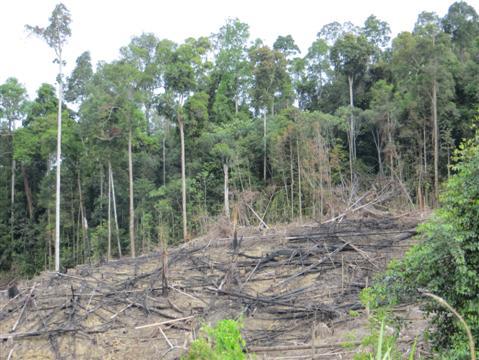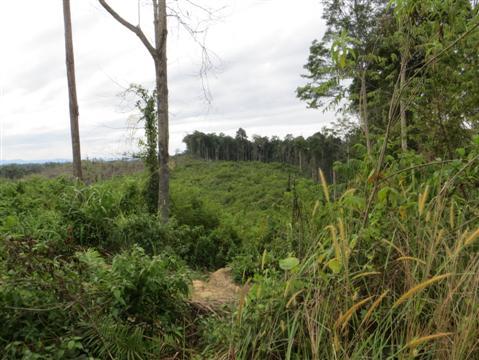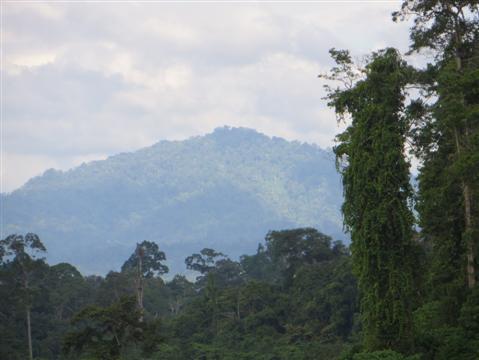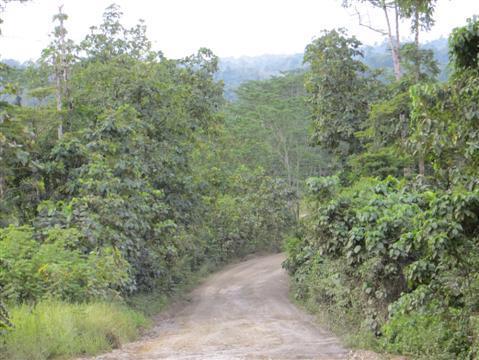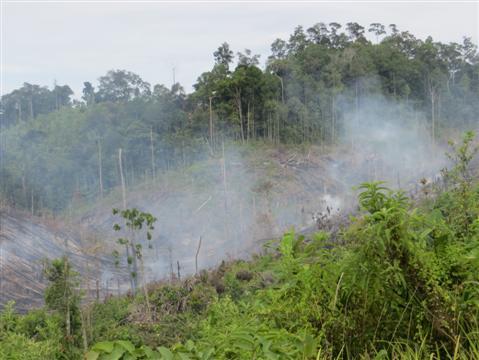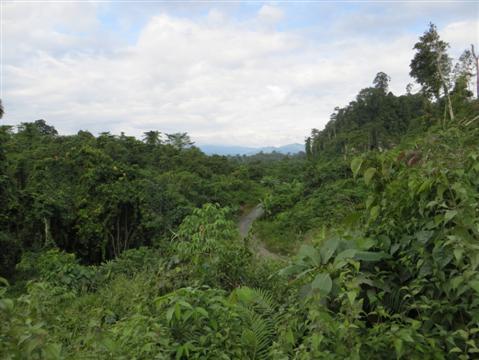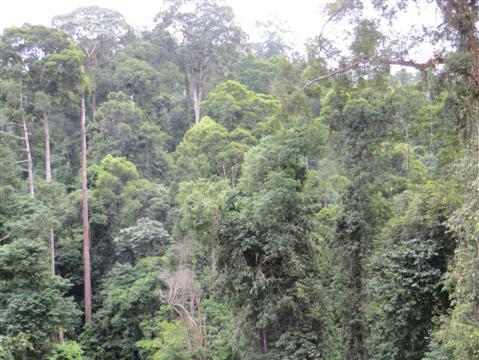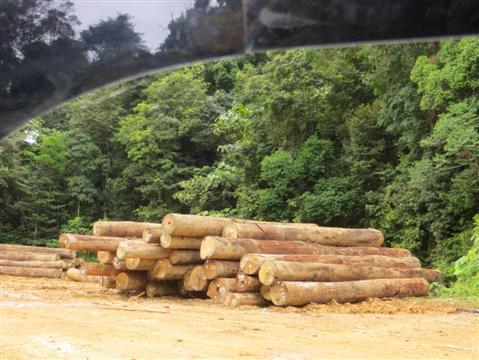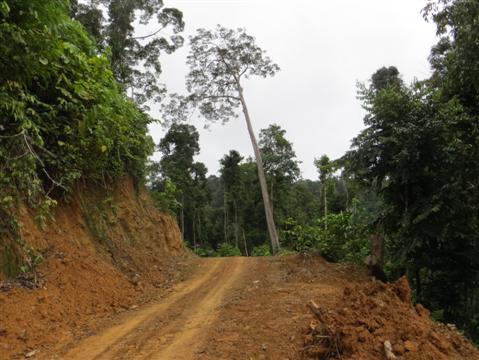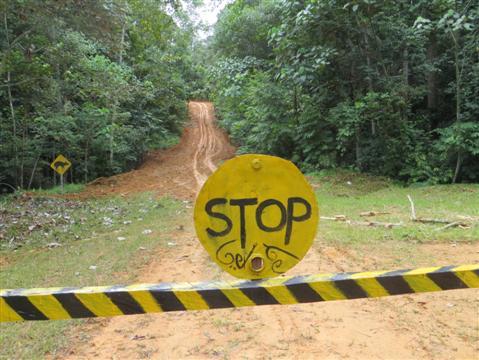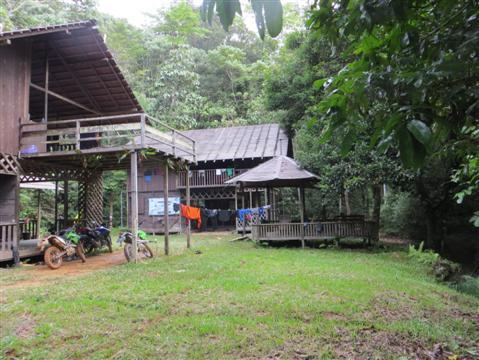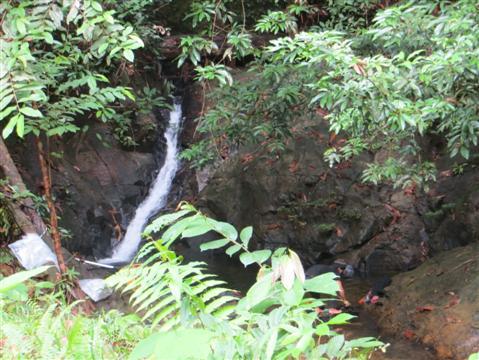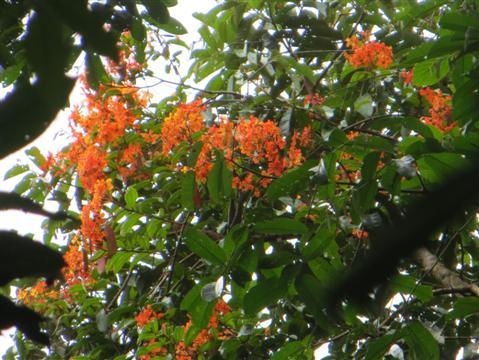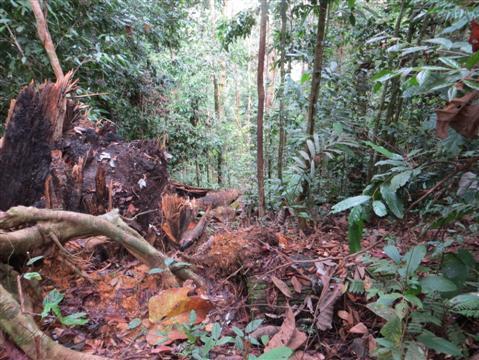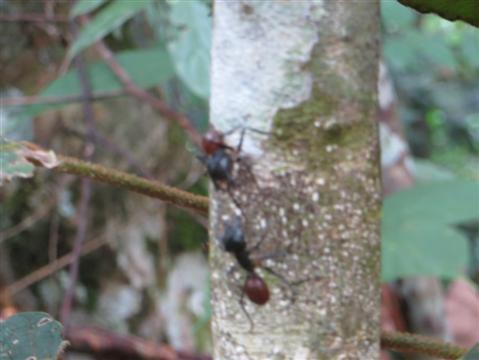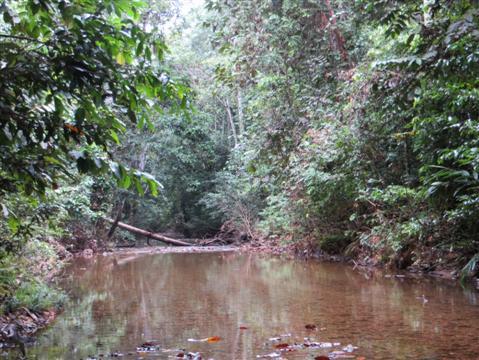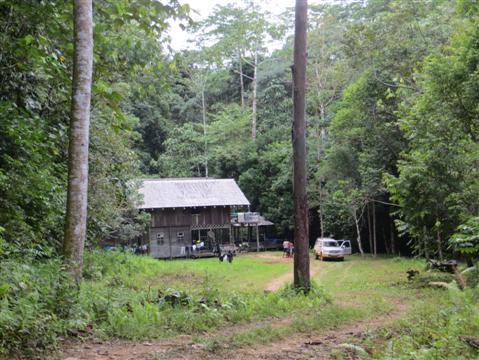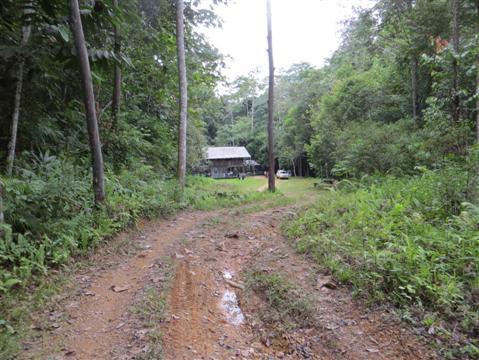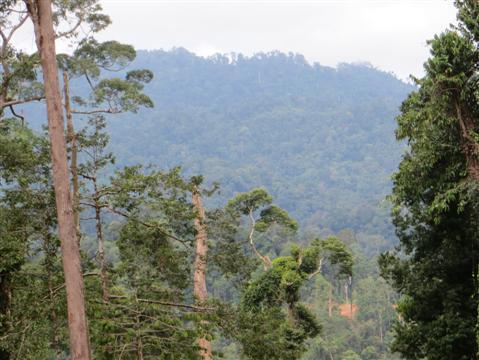In the mists and mountains of north-eastern Borneo indigenous Dayaks are struggling to save one of the fast dwindling tracts of primordial rain forest still left on the world's third largest island, aided by a non-governmental organisation (NGO) and banking on the potential for ecological tourism.
Getting there is not easy or cheap. Just the three-hour 4X4 trip from the nearest road-head near Muara Wahau costs $400 return, unless you're lucky enough to get a hitch. To get to Muara Wahau from Samarinda, the provincial capital, can take three days by bus.
Secondary jungle view
I plump for a four-day $1,000 'Wehea Rain Forest Adventure,' flying into Berau for the four-hour drive south to Muara Wahau.
As usual on the Looney Front, things don't go quite according to plan. At Berau airport., two gents rush up belatedly, identifying themselves as Eric, the guide, and Julianje, the driver. They push me into a dust-stained car to go to a crummy cafe.
More secondary jungle
We're still there an hour and a half later. Eric, who distorts his few English phrases so expertly that he sounds like Fronk, Martin Short's wedding planner in Father of the Bride, is mumbling on about a 'four-will wife.'
A phone call to the tour organiser in Samarinda, clarifies. A four-wheel drive will be along in a half an hour. Another hour and some odd-sounding phone calls later, they pile me into the same low-slung car and we're off. We'll meet the 4X4 along the way.
Dust swirls from open coal mining and fire scars still smoulder where locals have burned down the jungle for farming. The chainsaws of the would-be farmers whine away loud and clear.
Jungle being burned near Berau
At last we enter primary jungle. The road becomes atrocious - pot-holed, cratered, gulch-gouged. Just what our low-slung chariot needs! Julianje, who has just been overtaken by a snail, says it'll take another eight hours.
Forest view on the Berau-Muara Wahau road
He speaks English better than Eric. Both, it transpires, are Filipino scuba instructors from Derawan Island, Berau's main tourist draw. So what are two diving instructors, skilled as they may be in the watery deep, doing taking me into deepest primary jungle? To scuba up trees?
Four hours later, I get a response. It's nearly dark and we jounce to a halt. Across the way, a large trunk plonked behind and another in front, is a 4X4, with a very flat tyre. A dapper man rushes over.
'Hi, I'm Rahim, your jungle guide,' quoths he in perfect English.
And Eric? 'Ah, I asked him to take you along since I couldn't get to Berau. This is our third puncture. We've no more spares, so the driver's hitched to Berau with the two others for repairs.' He hands over a Dutch couple he's brought this far to Eric.
Another view from Berau-Muara Wahau road
And our onward drive? 'Oh don't worry, we'll hitch.' Without breaking a sweat, the ever-smiling can-do Rahim flags down a 4X4. In no time we're in the air-conditioned van winging over roads both smooth and rough - very rough. It's 8.30 pm when we reach Muara Wahau.
Next morning Rahim's bustling about with more glad tidings. The driver's still in Berau, tyres un-fixed. But two national park 4X4s are just round the corner. 'Just one problem,' he adds. 'They're both broken.'
Primary jungle
But can-do Rahim manages to pull a 4X4 out of his hat. It belongs to a lady driver, Efi, and he recruits her for the three-hour 45-mile drive. Let's just say her car's seen better days: the air conditioning died in the last century, the steering column cover is missing, yards of wire hang out of it, and other entrails protrude from various cavities.
Development and deforestation behind us, enveloped by the lushness of primary jungle, we're romping along a dirt track when we start waltzing gently to port. Within minutes it's graduated to a raucous grinding and we're rock 'n' rolling.
More primary jungle
Efi slams on the brakes. Our rear left wheel is sprayed outwards. Only one lug nut is left, empty holes the only evidence where the other five were. Our lives have been hanging by the nut equivalent of a hair.
Efi jacks us up, screws in two spares she has for just such occasions, takes another from the right rear wheel, then bums others from a passing truck driver, who works for a logging concession granted within the primary forest outside the reserve.
Legal logging in primary forest
Large trucks loaded down with massive trunks pass in billowing clouds of orange dust as part of a sustainable logging initiative - strictly controlled by Dayak guard stations, size and number limited, endangered Ulin iron wood out of bounds.
The jungle track
We're grinding up a muddy incline when Efi stalls. Trees 150 feet tall and vast canopies of green fill the valleys and mountainsides. Humongous lianas conjure up 'Me Tarzan, You Jane' visions. The engine's so hot it won't start. We wait half an hour for it to cool.
Waiting for the 4X4 to cool
A few hundred yards on, Efi does a reprise. At last we reach the entrance to the 147-square-mile park, about half the land area of New York City, home to orangutans, gibbons, macaques, cloud leopards and much else threatened by deforestation..
Park entrance
The lodge, by a jungle stream and little waterfall, is a basic two-storey hut of creaky rickety planks and bare rooms, with a sit-down toilet and cold shower.
Wehea jungle lodge
Brent Loken, ICON's Canadian executive director, would prefer no tree felling at all in the forest surrounding the park. But he says the logging here is an advance on indiscriminate felling, especially as palm oil plantations completely deplete the soil after 16 to 20 years, requiring huge amounts of pesticide. As for mining, that's even more devastating.
He notes that orangutans are more adaptable than previously thought and less adversely affected by this logging. He has also found that they walk much more on the ground than previously thought. If there's a path, they'll choose it rather than climb through the trees.
Little waterfall by lodge
Stephanie, a primatology professor from Wisconsin who's been coming here for the past five summers with her students, saw a big male orangutan with large cheek pads on the ground only yesterday. He climbed up a tree, threw down branches and made the so-called kiss-tweet noises that sound like a slobbery smacker followed by a whistle, to show his displeasure at the intrusion.
Time then for Yours Truly's walk in the woods. After an hour and a half of upping and downing forested hills, the grand total of sightings by our three musketeers - Rahim, Umar, a local Dayak guide, and Yours Truly - is exactly zilch.
Jungle bloom
Zilch, that is, except for the leeches which Rahim burns off my socks and shoes with his lighter. On the plus side I haven't yet fallen, while Rahim is even now sprawled on his arse in the mud with a bemused grin on his face.
Next morning we're again puffing up a steep muddy hill on the other side of the waterfall, on the ridge where Stephanie saw her orangutan. Brent saw him too. So our chances look good, right?
A few hours roaming around humongous fallen tree trunks, sliding on slickened leaves and sitting expectantly on damp branches listening to the loud electronic whistles of the insects - and not even can-do Rahim can bring on Stephanie's orangutan.
Where lightning strikes
Our grand total: two giant ants fighting or mating - that's the same thing, ain't it? - on a tree trunk, many bird sounds, and two leeches on my socks. Make that three. Blood traces on my calf show a third sucked right through my jeans.
Jungle ants having a go
Some hikes are strenuous, up steep mountainsides through almost impenetrable vegetation to waterfalls and look-outs. They can take hours - and buckets of sweat - just to cover a few miles. I'm not into that, so in the afternoon we walk by the riverside. This time even the leeches ignore me.
Jungle stream
One last chance, a night walk - actually a nip across the grass to the other shack where a ranger has spotted a greater slow loris, a civet-like animal with blue eyes. 'This is the one animal you will see,' quoths Stephanie, 'you can't miss it. They throw out rice to attract them.'
We trip daintily across the grass to ground zero, our torchlight-girt foreheads bobbing expectantly. The bird has already flown, or whatever slow loris do as they scamper back up trees.
Jungle lodge
Rahim, Brent, Umar and Stephanie console me on my spiffing two days of animal spotting. It's not easy to spot animals in the jungle since they hide very well at the sound of intrusion, quoth they; one has to be extremely lucky; this is not like an African safari where animals appear on call, they add.
Others report greater luck here. Anyway, just being in primary jungle makes it worth it.
Approach to jungle lodge
Suddenly my luck turns. At the moment when my wildlife watch seems at its most jejune, an unprecedented jungle display takes place on the shack's porch. One of Stephanie's students, an ample guy, takes up a tiny mandolin, just like the one Marilyn Monroe strummed away at in Some Like It Hot - strumming away just like her.
